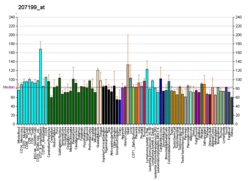Reverzna transkriptaza telomeraze
Reverzna transkriptaza telomeraze (TERT, ili hTERT kod ljudi) je katalitička podjedinica enzima telomeraza, koja, zajedno sa telomeraznom RNK komponentom (TERC), sačinjava najvažniju jedinicu telomeraznog kompleksa.[4][5]
Telomeraze su deo distinktne podgrupe RNK-zavisnih polimeraza. Telomeraze produžavaju telomere u DNK lancima, čime omogućavaju starećim ćelijama koje bi postale postmitotičke i podlegle apoptozi da premaše Hejflikov limit i postanu potencijalno besmrtne, kao što je to često slučaj sa ćelijama raka. Specifično, TERT je odgovoran za katalizu adicije nukleotida u TTAGGG sequenci na krajevima hromozomskih telomera.[6] Ova adicija ponavljajućih DNK sekvenci spečava degradaciju krajeva hromozoma nakon višestrukih ciklusa replikacije.[7]
hTERT odstustvo (obično usled hromozomske mutacije) je vezano za sindrom mačjeg plača.[8][9]
Interakcije
[уреди | уреди извор]Reverzna transkriptaza telomeraze formira interakcije sa:
Vidi još
[уреди | уреди извор]Reference
[уреди | уреди извор]- ^ а б в GRCm38: Ensembl release 89: ENSMUSG00000021611 - Ensembl, May 2017
- ^ „Human PubMed Reference:”. National Center for Biotechnology Information, U.S. National Library of Medicine.
- ^ „Mouse PubMed Reference:”. National Center for Biotechnology Information, U.S. National Library of Medicine.
- ^ Weinrich SL, Pruzan R, Ma L, Ouellette M, Tesmer VM, Holt SE, Bodnar AG, Lichtsteiner S, Kim NW, Trager JB, Taylor RD, Carlos R, Andrews WH, Wright WE, Shay JW, Harley CB, Morin GB (1997). „Reconstitution of human telomerase with the template RNA component hTR and the catalytic protein subunit hTRT”. Nat. Genet. 17 (4): 498—502. PMID 9398860. doi:10.1038/ng1297-498.
- ^ Kirkpatrick KL, Mokbel K (2001). „The significance of human telomerase reverse transcriptase (hTERT) in cancer”. Eur J Surg Oncol. 27 (8): 754—60. PMID 11735173. doi:10.1053/ejso.2001.1151.
- ^ Shampay J, Blackburn EH (1988). „Generation of telomere-length heterogeneity in Saccharomyces cerevisiae”. Proc. Natl. Acad. Sci. U.S.A. 85 (2): 534—8. PMC 279585
 . PMID 3277178. doi:10.1073/pnas.85.2.534.
. PMID 3277178. doi:10.1073/pnas.85.2.534.
- ^ Poole JC, Andrews LG, Tollefsbol TO (2001). „Activity, function, and gene regulation of the catalytic subunit of telomerase (hTERT)”. Gene. 269 (1-2): 1—12. PMID 11376932. doi:10.1016/S0378-1119(01)00440-1.
- ^ Zhang A, Zheng C, Hou M, Lindvall C, Li KJ, Erlandsson F, Björkholm M, Gruber A, Blennow E, Xu D (2003). „Deletion of the telomerase reverse transcriptase gene and haploinsufficiency of telomere maintenance in Cri du chat syndrome”. Am. J. Hum. Genet. 72 (4): 940—8. PMC 1180356
 . PMID 12629597. doi:10.1086/374565.
. PMID 12629597. doi:10.1086/374565.
- ^ Cerruti Mainardi P (2006). „Cri du Chat syndrome”. Orphanet J Rare Dis. 1: 33. PMC 1574300
 . PMID 16953888. doi:10.1186/1750-1172-1-33.
. PMID 16953888. doi:10.1186/1750-1172-1-33.
- ^ Haendeler J, Hoffmann J, Rahman S, Zeiher AM, Dimmeler S (2003). „Regulation of telomerase activity and anti-apoptotic function by protein-protein interaction and phosphorylation”. FEBS Lett. 536 (1-3): 180—6. PMID 12586360. doi:10.1016/S0014-5793(03)00058-9.
- ^ Kawauchi K, Ihjima K, Yamada O (2005). „IL-2 increases human telomerase reverse transcriptase activity transcriptionally and posttranslationally through phosphatidylinositol 3'-kinase/Akt, heat shock protein 90, and mammalian target of rapamycin in transformed NK cells”. J. Immunol. 174 (9): 5261—9. PMID 15843522. doi:10.4049/jimmunol.174.9.5261.
- ^ а б Chai W, Ford LP, Lenertz L, Wright WE, Shay JW (2002). „Human Ku70/80 associates physically with telomerase through interaction with hTERT”. J. Biol. Chem. 277 (49): 47242—7. PMID 12377759. doi:10.1074/jbc.M208542200.
- ^ Song H, Li Y, Chen G, Xing Z, Zhao J, Yokoyama KK, Li T, Zhao M (2004). „Human MCRS2, a cell-cycle-dependent protein, associates with LPTS/PinX1 and reduces the telomere length”. Biochem. Biophys. Res. Commun. 316 (4): 1116—23. PMID 15044100. doi:10.1016/j.bbrc.2004.02.166.
- ^ Khurts S, Masutomi K, Delgermaa L, Arai K, Oishi N, Mizuno H, Hayashi N, Hahn WC, Murakami S (2004). „Nucleolin interacts with telomerase”. J. Biol. Chem. 279 (49): 51508—15. PMID 15371412. doi:10.1074/jbc.M407643200.
- ^ Zhou XZ, Lu KP (2001). „The Pin2/TRF1-interacting protein PinX1 is a potent telomerase inhibitor”. Cell. 107 (3): 347—59. PMID 11701125. doi:10.1016/S0092-8674(01)00538-4.
- ^ Seimiya H, Sawada H, Muramatsu Y, Shimizu M, Ohko K, Yamane K, Tsuruo T (2000). „Involvement of 14-3-3 proteins in nuclear localization of telomerase”. EMBO J. 19 (11): 2652—61. PMC 212742
 . PMID 10835362. doi:10.1093/emboj/19.11.2652.
. PMID 10835362. doi:10.1093/emboj/19.11.2652.
Literatura
[уреди | уреди извор]- Mattson MP, Fu W, Zhang P (2001). „Emerging roles for telomerase in regulating cell differentiation and survival: a neuroscientist's perspective”. Mech. Ageing Dev. 122 (7): 659—71. PMID 11322991. doi:10.1016/S0047-6374(01)00221-4.
- Castillo Ureta H, Barrera Saldaña HA, Martínez Rodríguez HG (2003). „[Telomerase: an enzyme with multiple applications in cancer research]”. Rev. Invest. Clin. 54 (4): 342—8. PMID 12415959.
- Janknecht R (2004). „On the road to immortality: hTERT upregulation in cancer cells”. FEBS Lett. 564 (1–2): 9—13. PMID 15094035. doi:10.1016/S0014-5793(04)00356-4.
- Cristofari G, Sikora K, Lingner J (2007). „Telomerase unplugged”. ACS Chem. Biol. 2 (3): 155—8. PMID 17373762. doi:10.1021/cb700037c.
- Beliveau A, Yaswen P (2007). „Soothing the watchman: telomerase reduces the p53-dependent cellular stress response”. Cell Cycle. 6 (11): 1284—7. PMID 17534147. doi:10.4161/cc.6.11.4298.
- Bellon M, Nicot C (2007). „Telomerase: a crucial player in HTLV-I-induced human T-cell leukemia”. Cancer genomics & proteomics. 4 (1): 21—5. PMID 17726237.
Spoljašnje veze
[уреди | уреди извор]- GeneReviews/NCBI/NIH/UW entry on Dyskeratosis Congenita
- GeneReviews/NCBI/NIH/UW entry on Pulmonary Fibrosis, Familial
- TERT+protein,+human на US National Library of Medicine Medical Subject Headings (MeSH)


